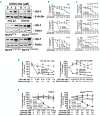Combined targeting of STAT3 and STAT5: a novel approach to overcome drug resistance in chronic myeloid leukemia
- PMID: 28596283
- PMCID: PMC5685220
- DOI: 10.3324/haematol.2016.163436
Combined targeting of STAT3 and STAT5: a novel approach to overcome drug resistance in chronic myeloid leukemia
Abstract
In chronic myeloid leukemia, resistance against BCR-ABL1 tyrosine kinase inhibitors can develop because of BCR-ABL1 mutations, activation of additional pro-oncogenic pathways, and stem cell resistance. Drug combinations covering a broad range of targets may overcome resistance. CDDO-Me (bardoxolone methyl) is a drug that inhibits the survival of leukemic cells by targeting different pro-survival molecules, including STAT3. We found that CDDO-Me inhibits proliferation and survival of tyrosine kinase inhibitor-resistant BCR-ABL1+ cell lines and primary leukemic cells, including cells harboring BCR-ABL1T315I or T315I+ compound mutations. Furthermore, CDDO-Me was found to block growth and survival of CD34+/CD38- leukemic stem cells (LSC). Moreover, CDDO-Me was found to produce synergistic growth-inhibitory effects when combined with BCR-ABL1 tyrosine kinase inhibitors. These drug-combinations were found to block multiple signaling cascades and molecules, including STAT3 and STAT5. Furthermore, combined targeting of STAT3 and STAT5 by shRNA and STAT5-targeting drugs also resulted in synergistic growth-inhibition, pointing to a new efficient concept of combinatorial STAT3 and STAT5 inhibition. However, CDDO-Me was also found to increase the expression of heme-oxygenase-1, a heat-shock-protein that triggers drug resistance and cell survival. We therefore combined CDDO-Me with the heme-oxygenase-1 inhibitor SMA-ZnPP, which also resulted in synergistic growth-inhibitory effects. Moreover, SMA-ZnPP was found to sensitize BCR-ABL1+ cells against the combination 'CDDO-Me+ tyrosine kinase inhibitor'. Together, combined targeting of STAT3, STAT5, and heme-oxygenase-1 overcomes resistance in BCR-ABL1+ cells, including stem cells and highly resistant sub-clones expressing BCR-ABL1T315I or T315I-compound mutations. Whether such drug-combinations are effective in tyrosine kinase inhibitor-resistant patients with chronic myeloid leukemia remains to be elucidated.
Copyright© 2017 Ferrata Storti Foundation.
Figures





Similar articles
-
Combined STAT3 and BCR-ABL1 inhibition induces synthetic lethality in therapy-resistant chronic myeloid leukemia.Leukemia. 2015 Mar;29(3):586-597. doi: 10.1038/leu.2014.245. Epub 2014 Aug 19. Leukemia. 2015. PMID: 25134459 Free PMC article.
-
JKST6, a novel multikinase modulator of the BCR-ABL1/STAT5 signaling pathway that potentiates direct BCR-ABL1 inhibition and overcomes imatinib resistance in chronic myelogenous leukemia.Biomed Pharmacother. 2021 Dec;144:112330. doi: 10.1016/j.biopha.2021.112330. Epub 2021 Oct 19. Biomed Pharmacother. 2021. PMID: 34673425
-
CDK4/CDK6 inhibition as a novel strategy to suppress the growth and survival of BCR-ABL1T315I+ clones in TKI-resistant CML.EBioMedicine. 2019 Dec;50:111-121. doi: 10.1016/j.ebiom.2019.11.004. Epub 2019 Nov 21. EBioMedicine. 2019. PMID: 31761618 Free PMC article.
-
Mechanisms of Resistance to ABL Kinase Inhibition in Chronic Myeloid Leukemia and the Development of Next Generation ABL Kinase Inhibitors.Hematol Oncol Clin North Am. 2017 Aug;31(4):589-612. doi: 10.1016/j.hoc.2017.04.007. Hematol Oncol Clin North Am. 2017. PMID: 28673390 Free PMC article. Review.
-
Implications of BCR-ABL1 kinase domain-mediated resistance in chronic myeloid leukemia.Leuk Res. 2014 Jan;38(1):10-20. doi: 10.1016/j.leukres.2013.09.011. Epub 2013 Sep 23. Leuk Res. 2014. PMID: 24131888 Review.
Cited by
-
HDAC inhibitor chidamide overcomes drug resistance in chronic myeloid leukemia with the T315i mutation through the Akt-autophagy pathway.Hum Cell. 2023 Jul;36(4):1564-1577. doi: 10.1007/s13577-023-00919-1. Epub 2023 May 24. Hum Cell. 2023. PMID: 37222919
-
Pharmacological Inhibition of Oncogenic STAT3 and STAT5 Signaling in Hematopoietic Cancers.Cancers (Basel). 2020 Jan 18;12(1):240. doi: 10.3390/cancers12010240. Cancers (Basel). 2020. PMID: 31963765 Free PMC article. Review.
-
A kinase profile-adapted drug combination elicits synergistic cooperative effects on leukemic cells carrying BCR-ABL1T315I in Ph+ CML.Leuk Res. 2019 Mar;78:36-44. doi: 10.1016/j.leukres.2018.12.013. Epub 2018 Dec 28. Leuk Res. 2019. PMID: 30711891 Free PMC article.
-
Balancing STAT Activity as a Therapeutic Strategy.Cancers (Basel). 2019 Nov 3;11(11):1716. doi: 10.3390/cancers11111716. Cancers (Basel). 2019. PMID: 31684144 Free PMC article. Review.
-
Selective activation of STAT3 and STAT5 dictates the fate of myeloid progenitor cells.Cell Death Discov. 2023 Jul 28;9(1):274. doi: 10.1038/s41420-023-01575-y. Cell Death Discov. 2023. PMID: 37507383 Free PMC article.
References
-
- Nowell PC, Hungerford DA. A minute chromosome in human granulocytic leukemia. Science. 1960;132:1497.
-
- Rowley JD. A new consistent chromosomal abnormality in chronic myelogenous leukaemia identified by quinacrine fluorescence and Giemsa staining. Nature. 1973;243(5405):290–293. - PubMed
-
- Bedi A, Zehnbauer BA, Barber JP, Sharkis SJ, Jones RJ. Inhibition of apoptosis by BCR-ABL in chronic myeloid leukemia. Blood. 1994;83(8):2038–2044. - PubMed
-
- Druker BJ, Talpaz M, Resta DJ, et al. Efficacy and safety of a specific inhibitor of the BCR-ABL tyrosine kinase in chronic myeloid leukemia. N Engl J Med. 2001;344(14):1031–1037. - PubMed
-
- Kantarjian H, Sawyers C, Hochhaus A, et al. Hematologic and cytogenetic responses to imatinib mesylate in chronic myelogenous leukemia. N Engl J Med. 2002;346(9):645–652. - PubMed
Publication types
MeSH terms
Substances
Grants and funding
LinkOut - more resources
Full Text Sources
Other Literature Sources
Medical
Molecular Biology Databases
Research Materials
Miscellaneous

